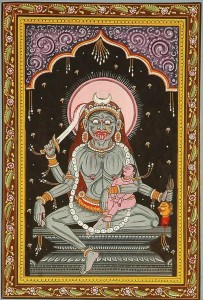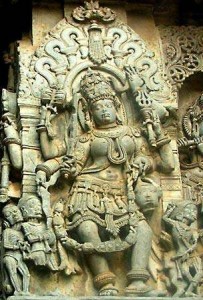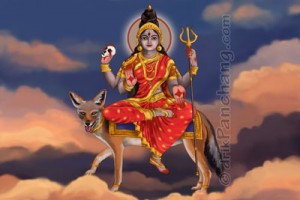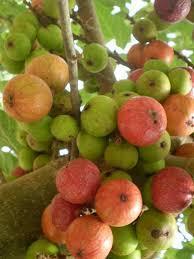चामुंडा
दष्टत्रला क्षीण देहा च गात्र कर्षणा भी मृद्ड़नी
दिग-बहुक्षम कुशिसा मुसलन चक्र म मार्गाणुम।।
अंकुशा बिभर्ति खड्गम् दक्षिणेस्वताः
खेतासा धनुर दंडम कुठारम चलति बिभर्ति ।।
चामुण्डा प्रेतगा रक्ता बिक्रातस्याही भूषणतः
द्विभुजा प्राकटर्य कृतिका कार्या मनुइन्त्रा ।।
(रूपमन्ड़ना)
चामुंडा को चामुंडी और चर्चिका के नाम से भी जाना जाता है। वह देवी चंडी की शक्ति है। देवी महात्म्य में उन्हें काली का प्रतिरूप माना हैं क्योंकि उनका स्वरूप और आदत चामुंडा के समान है और काली को चामुंडा के रूप में तब माना जाता है, जब वह चंड़ और मुंड को वध कर देती है।
वह मातृका-समूह में हमेशा अंतिम रहती हैं। अन्य मातृकाओ को उनके पुरुष देवताओं की शक्तियों और उनके सम स्वरूप से ही जाना जाता है, केवल चामुंडा ही एकमात्र मातृका है जो एक पुरुष देवता के बजाय महान ‘देवीयो’ की शक्ति है।
जब वह महालक्ष्मी (ऐम), महासरस्वती (ह्रीम) और महाकाली (किल्म) की शक्ति का संयोजन अपने आप में करती हैं, तब वह अपने इस समस्ती रूप में ब्रह्म की प्रकृति के रूप में ब्रह्मा-स्वरूपिणी महादेवी चामुंडा कहलाती हैं।
उनका स्वरूप:
काले रंग की चामुंडा को मुंडो की माला की पहने हुये या मुंडमाला को यज्ञोपवीत के जैसे पहने हुये वर्णित किया गया है। उनकी तीन आंखें हैं जो लाल रंग की है, उनके भयानक चेहरे पर शक्तिशाली दाँत हैं, धँसा हुआ पेट, बहुत ही क्षीण शरीर, मुंह विकृत और जीभ बाहर निकली हुई, नशीली आँखें, उलझे, बिखरे हुये मोटे, कड़े, खड़े बाल और और दस हाथ है। वह उलझे हुए बालो का बहुत बड़ा जटा-मुकुट पहने हुये है, जो साँप या खोपड़ी के आभूषणों से सज्जित हैं। वह शंख से बने कुंडल पहने हुये है। कभी-कभी वह सिर पर एक अर्धचंद्राकार चंद्रमा भी पहने दिखाई देती है। उनका वस्त्र बाघ की खाल है और वह हड्डियों, खोपड़ी, नाग और बिच्छू के आभूषण पहनती है जो बीमारी और मृत्यु के प्रतीक हैं। उनका वाहन एक उल्लू या सियार है और उनकी ध्वजा का प्रतीक गरूड़ है।
उनके आसन पर विभिन्न मत है:
-
-
- वे एक अंजीर के पेड़ के नीचे पद्मासन में बैठी है;
- वे तीन खोपड़ियों वाले आसन पर बैठती है;
- मनुष्य के मृत शरीर पर पद्मासन में बैठीहैं;
- वह एक वह पुरुष के शव या प्रेत पर पैर रख कर खड़ी है।
-
चतृर्भुजी:
- अपने चार हाथों में वह एक डमरू, त्रिशूल, तलवार और पानीपात्र धारण किए हुए हैं।
उनके एक हाथ में कपाल (खोपड़ी) और दूसरे हाथ में सुला है जबकि अन्य दो हाथ क्रमशः अभय और वरद मुद्रा में हैं। - उनके बाएं हाथ में कपाल है, जो मांस से भरा है और दूसरे हाथ में आग है। दाहिने हाथ में सांप और दूसरा हाथ अभय मुद्रा में है।
दसम एवं द्वादश भुजी:
- विष्णुधर्मोत्तर के अनुसार वे अपने हाथों में : मुसल, कवच, बाण, खड्ग, खेतका, धनुष, दंड, परशु, अभय और वरद मुद्रा धारण किए हुए हैं।
- पुर्वकर्णगमा के अनुसार: वे डमरू (ढोल), त्रिशूल, तलवार, साँप, खटवांग, वज्र, कटा हुआ सिर, पानीपात्र या कपाल रक्त से भरा हुआ, अग्नि का कलश और अभय या वरद मुद्रा धारण किए हुए हैं।
ॐ पिशाचा ध्वजाये विदमहे,
शूला हस्ताय धीमहि।
तन्नौः काली प्रचोदयात।।
अंजीर या गूलर के पेड़ की प्रतीकात्मकता
‘उदुम्बर’ अंजीर के पेड़ का संस्कृत नाम है। अन्य संस्कृत के नाम हैं, अपुष्पा फला सम्बन्ध, हरितक्ष, और हेमदुग्धा। यह भारत का मूल निवासी है और इसका वैज्ञानिक नाम ‘फिकस रेसमोस’ है। हमारे ऋर्षि मनीषीयों ने अपनी दूरदर्शिता से अंजीर के पेड़ को धार्मिकता से जोड़ दिया कि देवी चामुंडा अंजीर के पेड़ के नीचे बैठी है, जिस से आम आदमी पेड़ को संरक्षित करेगा, जो मनुष्य के लिए बहुत उपयोगी है। इस पेड़ को संरक्षित क्यों किया जाना चाहिए, यह इसके निम्न औषधीय गुणों के आधार पर निर्णित किया जा सकता है।
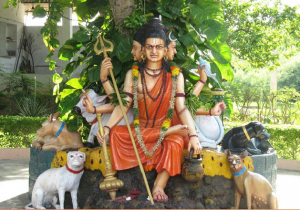
पौराणिक संदर्भ
- वेदों के अनुसार, भगवान विष्णु वृक्ष के अवतार हैं और उदुम्बरा के नाम से जाने जाते हैं। यह पेड़ सौभाग्य का प्रतीक है, समृद्धि लाता है और दुश्मनों को नष्ट करता है।
- इसकी पवित्र लकड़ी का उपयोग हवन या यज्ञ में किया जाता है। राजा हरीशचंद्र का सिंहासन उदुम्बरा से बना था और राजा भगवान के नाम का जाप करते हुए अपने घुटनों पर चढ़ कर सिंहासन पर बैठते थे। ऐसी मान्यता थी की ऐसे करने से राजा अपने साथ भगवान को भी साथ सिंहासन पर आसीन करते थे।
- प्राचीन समय में, उप हिमालयी क्षेत्र में एक योद्धा कबीला था, जिसे ‘उदुम्बरा’ के नाम से जाना जाता था, वहाँ से उदुम्बरा वृक्ष के रूपांकनों वाले सिक्के भी मिले थे।
- बौद्ध ग्रंथों में उदुम्बरा को नील कमल के रूप में जाना जाता है और इसे पवित्र माना जाता है, क्योंकि पूर्व बुद्ध- कनकमुनि (पाली में कनक मना) ने इस वृक्ष के नीचे आत्मज्ञान प्राप्त किया था।
- गुरु दत्तात्रेय, जिसे त्रिदेव के रूप में जाना जाता है, इस पेड़ में निवास करते हैं, इसलिये उनका मंदिर अंजीर के पेड़ों से घिरा हुआ होता है। गुरु चरित्र के अनुसार यह वृक्ष कलियुग का ‘कल्पतरु’ है।
औषधीय गुण
उदुम्बरा एक प्राचीन औषधीय पौधा है जो पूरा दिन ऑक्सीजन उत्पन्न करता रहता है। पौधे के सभी भागों से जैसे पत्ते, फल, छाल, जड़. गोंद (लेटेक्स) और रस, विभिन्न औषधीय प्रयोजनों के लिए उपयोग किया जाता है। अथर्ववेद में कहा गया है कि इसमें त्वचा संबंधी बीमारियों को ठीक करने की शक्ति है और ऋग्वेद कहता है कि यह बवासीर, कीड़े के कारण आंतों के अल्सर के उपचार में प्रभावी है और रक्त शोधक के रूप में काम करता है।
महर्षि चरक ने विभिन्न रोगों के लिए इस वृक्ष से निर्मित जड़ी-बूटियों का वर्गीकरण किया है, जैसे: सूजन-नाशक,ज्वरनाशक, मूत्र विसर्जन को नियंत्रित करने वाला,जीवाणु-नाशक,
लिवर का सुरक्षा कवच, एंटीऑक्सिडेंट, कीमो (कोशिकायें जो कैंसर में बढ़ती हैं) निवारक, फाइलेरिया-नाशक आदि। इस की जड़ी-बूटियों से फ्रैक्चर जल्दी ठीक हो जाते हैं। इससे रक्त, पित्त, जलन, मोटापा और योनि से संबंधित विकारों में राहत मिलती है।
संदर्भ:
The Story Of Matrikas – Hindu Mythology
www.sanskritimagazine.com/indian-religions/hinduism/sapta-matrikas-the-seven-divine-mothers/
kaulapedia.com/en/ashta-matrika/
www. templepurohit.com
https://sreenivasaraos.com/2012/10/07/saptamatrka-part-four/sapta-matrikas-the-seven-divine-mothers/
https://www.hinduscriptures.in/vedic-lifestyle/food/trees/udumbara
Google Search
www.Wikipedia.com
Photos: wikipedia
www.DrikPanchang.com
Statue: Chamunda, sculpture in Halebid, India : .Mohonu britannica.com
CHAMUNDA
Dastrala kshindeha chagatrakarshana bhimrudani
Dig-bahuksham kushisa musalan chakra marganaum।।
Ankusha bibharti khadgam daksnesvatah
Khetaasa dhanurdandam kutharam chalti bibarti।।
Chamunda pretaga raktha bikratasyahi bhusanath
Dvibhuja prakatray kartika karyamnuintra ।।
Chamunda is known as Chamundi and Charchika is the power of Devi (Chandi). Devi Mahatmaya identified her with Kali and is similar in her appearance and habit and Kali is celebrated as Chamunda after she overpowers and beheads Chanda and Munda.
She is always portrayed last in the group. While other Matrikas are considered as Saktis (powers) of male divinities and resemble them in their appearance, Chamunda is the only Matrika who is a Shakti of the great Goddess ‘Devi’ rather than a male god. She consider the Mahadevi Chamunda, in her integrated form (Samasti), as of the nature of the Brahman- Brahma-svarupini. She combines in herself her other diversified (Vyasti) forms of Mahalakshmi (Aim); Mahasarasvathi (Hrim); and, Mahakali (Kilm).
Unlike other Matrikas, Chamunda is an independent goddess. She is also praised as the fertility goddess of Vindhya Mountains and associated with Yama.
Her appearence:
The black coloured Chamunda is described as wearing a garland of severed heads or skulls (Mundamala) in the manner of the Yajnopavita. She has three eyes and is red in colour, a terrifying face with a powerful tusks and a sunken belly, a very emaciated body, mouth hideously distorted and the tongue protruding out, drunken eyes, hair is abundant and thick and bristles upwards and ten hands. She wears a very heavy jata-makuta formed of piled, matted hair tied with snakes or skull ornaments. She wears Kundalas made of Conch shell (Sankha Patra. Sometimes, a crescent moon is seen on her head. Her garment is the tiger skin and she wears ornaments of bones, skulls, serpents and scorpions, symbols of disease and death. Her Vahana is an Owl or a Jackal and the emblem of her banner is an Eagle.
There is a variation on her seat:
-
- She is seated in Padmasana under a fig tree;
- She sits upon a seat made of three skulls;
- Seated in Padmasana on the dead body of a human being;
- She has a cadaver for footrest;
- She is standing on a corpse of a male (shava or preta).
When she depicted as four hands:
- In her four hands she is holding a Damaru, trishula, sword and panapatra.
- She has Kapala (Skull) in one hand and Sula in another while the other two hands are respectively in the Abhaya and Varada poses.
- In one of her left hands she carries a Kapala which is filled with lumps of flesh; and in another left hand there is fire. In one right hand she holds a snake and one in abhaya.
When she depicted as ten to twelve arms:
- According to Vishnudharmottara she carries in her hand the following things: Musala, Kavacha, Bana, Khadga, Khetaka, Dhanus, Danda, Parasu, Abhaya and Varada poses.
- According to the Purvakaranagama: she is holding a Damaru (drum), trishula (trident), sword, a snake, skull-mace (khatvanga), thunderbolt, a severed head, pantatra (drinking vessel) or skull-bowl (kapala) filled with blood, an urn of fire and Abhaya or Varada poses.
Aum Pisaasath-vajaaya Vidmahe
Soola Hasthaya Dhimahee
Thanno Kali Prachodayath
Symbolism of a Fig or Goolar Tree
Udumbara is the Sanskrit name for the fig tree. The other Sanskrit names are Apushpa phala sambandha, Haritaksha, and Hemadugda. It is a native of India and its scientific name is Ficus racemose. The significance of Goddess Chamunda seated under a fig tree is that if we can relate this to religious purpose, the common man will preserve the tree, which is very useful for a human being. Why this tree must be preserved can be judge by it’s medicinal properties.
Puranic Reference:
• According to the Vedas, Lord Vishnu is an embodiment of the tree and known as Udumbara. This tree symbolises good luck, brings prosperity and destroy enemies.
 • The wood being sacred is used in havan or yagna. The throne of Raja Harish Chandra was made of Udumbara and the king would ascend the throne on his knees chanting the names of God.
• The wood being sacred is used in havan or yagna. The throne of Raja Harish Chandra was made of Udumbara and the king would ascend the throne on his knees chanting the names of God.
• In ancient times, there was a warrior clan known as ‘Udumbara’ in the Sub Himalayan region, where coins with motifs of the Udumbara tree were found.
• In Buddhists texts Udumbara is known as the Blue Lotus (Nila Kamal) and considered sacred, as a former Buddha- Konagamana had attained enlightenment under this tree.
• Guru Dattatreya, known as the Holy Trinity resides in this tree that’s why his temple is surrounded with fig trees. According to Guru Charita this tree is considered as the ‘Kalpataru of Kaliyuga’,
Medicinal properties
Udumbara is an ancient medicinal plant that generates oxygen throughout the entire day. All parts of the plant like the leaves, fruits, its bark, latex and sap of the root are used for a variety of medicinal purposes. Atharva Veda states that it has the power to heal skin related ailments and Rig Veda says that it is effective in the treatment of piles, intestinal ulcers caused by worms and works as a blood purifier.
Maharishi Chakra has classified the herbs made from this tree for various diseases, such as: Anti inflammatory, anti pyretic, anti diuretic, anti bacterial, hepto protective, antioxidant, chemo preventive, anti filarial, etc. The herb hastens healing in fractures, gives relief in rakta pitta, burning sensation, obesity and vaginal disorders.
References:
The Story Of Matrikas – Hindu Mythology
www.sanskritimagazine.com/indian-religions/hinduismhttps://sreenivasaraos.com/2012/10/07/saptamatrka-part-four/sapta-matrikas-the-seven-divine-mothers/
www. templepurohit.com
kaulapedia.com/en/ashta-matrika/
https://www.hinduscriptures.in/vedic-lifestyle/food/trees/udumbara
Google Search
www.Wikipedia.com
Photos: wikipedia
www.DrikPanchang.com
Statue: Chamunda, sculpture in Halebid, India : .Mohonu britannica.com


